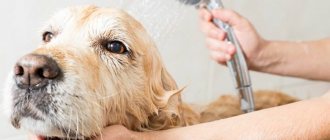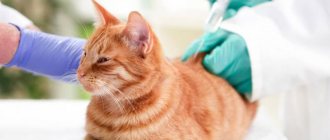Why rabies is not curable How vaccination works How to properly vaccinate dogs against rabies How rabies vaccination can be dangerous When rabies vaccination is necessary Rabies is one of the most dangerous viral diseases common to humans and dogs. The fatal outcome after the onset of rabies symptoms during infection is 100%, that is, all infected individuals die. And the only way to prevent this disease is timely vaccination of dogs and other carnivorous animals living near humans.
The rabies virus is distributed throughout the world, except in island countries. And large cities, including Moscow and the Moscow region, are no exception. Every year in Moscow, several districts are quarantined for rabies (about 40 cases of rabies in dogs were registered in 2021). Therefore, it is very important that every dog is vaccinated against this disease, and therefore the same requirement is imposed by Russian legislation - according to paragraph 9.6 of the sanitary and epidemiological rules SP 3.1.7.2627-10, all domestic carnivores (dogs, cats, ferrets, etc.) must be vaccinated against rabies.
What is rabies in dogs
Rabies is otherwise interpreted as a fear of water. It belongs to the category of deadly diseases. The source of the disease is a neurotropic virus belonging to the rhabdovirus family. First of all, the organs of the central nervous system are affected without the possibility of starting recovery processes. Rabies is caused by sick animals spreading the virus through interaction with healthy dogs. Such animals include birds, cats, dogs, and predators.
Incubation can last from several days to 2–4 months; the virus in saliva is detected 5–6 days before the first symptoms of rabies appear.
Infection occurs during a bite through the mucous membranes. As a rule, the virus is formed in the salivary glands. A small part of it is also excreted in urine and feces. The virus, penetrating the body, not only travels through the blood, but also involves nerve endings and affects the spinal cord and brain.
The virus tolerates frost well, but dies at temperatures above 56 degrees Celsius within 15–20 minutes. Direct sunlight, standard disinfectants, and alcohol also help fight the virus. But! Resistant to phenols, does not die during processing.
Due to the increased degree of preservation of the virus, it is constantly in the environment and causes harm to unvaccinated dogs and other animals. There are rumors that after eating contaminated meat, a dog can catch the virus, but this has not yet been confirmed in scientific studies.
Once a year, get a comprehensive vaccination that will protect your dog from contracting rabies and other life-threatening diseases.
Main signs of infection:
- Anxiety, excitability, partial fear of the sounds of water;
- Gradual refusal of water, the appearance of aggression towards people and other animals;
- The appearance of foamy saliva from the mouth, as muscle paralysis prevents swallowing;
- Desire to eat inedible things.
If you notice similar symptoms in your pet, you should immediately isolate it in a separate room and call a veterinarian to determine the diagnosis and provide first aid. Such a dog can harm people who are in the room.
For humans, this disease is also fatal, so you should be wary of stray dog bites, since they are unlikely to have a rabies injection. There have been cases when a successful cure occurred when a person was immersed in a very deep coma.
But this method is unsafe, as it can cause the development of severe mental disorders.
Forms of rabies stage
Rabies is characterized by acute and hyperacute forms. The infection itself develops in the following stages:
- Prodromal – duration is 48–72 hours, characterized by changes in the pet’s behavior, the appearance of anxiety and inadequate reaction to stimuli, the desire to hide in a secluded place and hide from all people, or, conversely, an increased demand for attention appears. Possible aggression;
- Manic – the pet’s mood is constantly changing, aggression can turn into apathy in a few minutes, interest in following commands is lost, and disobedience begins. Foamy salivation appears, aggression towards people and other animals is noticed. The dog is capable of running away from home;
- Paralytic or silent - severe apathy appears, paralysis of the muscles of the pharynx and hind limbs develops, the tongue begins to fall out, appetite disappears due to pain in the larynx, breathing and heart rhythm are disturbed. After a few days, the dog falls into a coma and dies from exhaustion and irreversible processes in the body.
Other stages of rabies are possible:
- Atypical - a characteristic sign is the appearance of gastroenteritis, accompanied by refusal of food, foamy vomiting with blood, diarrhea;
- Abortive (in bitches);
- Recurrent - at first the symptoms disappear, then reappear after a few days.
Symptoms of the disease
It is not possible to recognize the disease immediately, which leads to the widespread prevalence of infection. Most often, the diagnosis becomes clear when the dog’s virus production is particularly powerful.
Incubation period
The latent, or incubation, period lasts on average from a month to one and a half. In dogs of small breeds, animals with weakened immune systems, as well as in puppies, this period can last about a week. In rare cases, the latent phase of the disease can last several months.
First signs
The very first “alarm bell” is that the dog constantly scratches the bite site, if there is one. If infection occurs through abrasions in the oral cavity, she begins to actively gnaw bones and furniture to soothe the itching at the site of the virus.
In general, for all forms, except atypical ones, the prodromal (primary) stage is the same. The dog becomes lethargic, apathetic, and ignores attempts to play. She strives for peace and solitude, hiding under furniture and in dark corners. Sometimes such melancholy abruptly gives way to unexpected tenderness - the dog tries to caress as if he was apologizing for something, then again goes into a dark corner. Such changes in mood should certainly alert the owner.
Advice! If you notice changes in the animal’s behavior, a sharp change from a lethargic state to an active (ingratiating) state, take the animal to the veterinarian!
initial stage
The stage of aggression, or excitement, shows the first symptomatic and differentiating signs of the disease - melancholicity gives way to aggression . The dog tries to chew and grab everything that surrounds it, while not controlling the force of its bites. In such attacks, the animal often breaks its teeth and sometimes its jaw. There is no fear of people (this is especially noticeable in previously timid and cowardly dogs).
Characteristic symptoms at this stage are the absence of barking; the animal can only wheeze or howl. The key is the fear of water (from which the disease received the name “hydrophobia”), the animal becomes frightened and nervous even at the sound of pouring water, and paralysis of the larynx and lower jaw occurs . The dog cannot drink water; saliva begins to flow from its mouth, which can foam.
IMPORTANT! During this period, the animal releases a large amount of virus into the environment, which is contained in saliva and blood. Any scratch or bite on a person or a healthy animal can be fatal to them.
Attacks of aggression are replaced by apathy and powerlessness, but at the slightest irritation (loud sound, whistle, bright light) he again begins to violently rush at everything around him. At this stage the dog is very dangerous.
Late stage
After the stage of aggression, complete apathy sets in, the dog refuses food and water, and does not react to external stimuli. Breathing becomes shallow and frequent, convulsive seizures occur. Death occurs due to paralysis of the larynx and disruption of the cardiovascular system.
How to recognize rabies in domestic dogs?
Domestic apartment dogs can become infected while walking if they are let off a leash. Communication with stray dogs that may be carriers of the virus, clashes with them, attempts to hunt rats or mice can be harmful.
Important! If an animal begins to avoid communicating with a person for no reason, hides, or stops responding to commands, this is a reason to contact a veterinarian. You should not delay this until attacks of aggression appear.
Homeless
Stray dogs are more at risk of infection - no one vaccinates them or controls their interaction with other animals. It is possible to detect rabies in such dogs only in the manic stage - a slack jaw, flowing foamy saliva, and slanted eyes should alert a passerby . If you suspect rabies in stray yard dogs, you should immediately notify the veterinary inspection service - the animal poses a threat to everyone around you.
ATTENTION! Mad dogs attack WITHOUT the usual warning of a growl or flattened ears.
Symptoms in small breed dogs
Symptoms in large and small breeds of dogs do not differ - the course of the disease does not depend on the breed .
Vaccines for dogs against rabies
Mandatory vaccination is established at the state level. Without a note in the dog's passport about vaccination, it is impossible to participate in exhibitions. And also, customs does not allow such animals through; they can forcibly confiscate them and vaccinate them.
In some countries, there is criminal liability for failure to vaccinate animals. This is taken very seriously all over the world; you should not vaccinate your animal on time to protect yourself and save the life of your pet.
The following types of vaccines are used in the Russian Federation:
- Nobivak Rabies is a Dutch-made product that belongs to the category of those that do not contain a live pathogen. Its uniqueness lies in the possibility of using the vaccine as a solvent for other Nobivak vaccinations, which makes it possible to immediately protect the animal from several diseases;
- Rabix - also belongs to the category of vaccines that do not have a live pathogen; use is allowed from eight weeks of a pet’s life. A distinctive feature of the vaccine is that it is a secondary revaccination of the first vaccination of animals. It is carried out after 21 days, then every year the animals are vaccinated once;
- Dohivac is a Dutch-made drug that also does not contain a live pathogen and is similar in characteristics to Nobivak;
- Febrivac 3 plus is a drug of German origin, without a live pathogen in its composition, similar to Nobivak.
Before choosing a vaccine, you should consult with a veterinary clinic, study reviews both on the Internet and from pet owners and professional breeders. Choosing the right vaccine will keep you and your pet safe.
If you plan to breed, you must first prepare the dog so that the pregnancy is easy and without complications. A month before pregnancy, bitches are vaccinated against viral infections, dewormed, and protected from insects. Is a rabies vaccination necessary for a pregnant dog? Of course, all doctors believe that it is necessary to vaccinate the dog before a planned mating.
If pregnancy occurs, it is recommended to vaccinate the dog in the first third of pregnancy, that is, 19–21 days after mating. It is necessary to read the instructions carefully; the manufacturer indicates whether there are any contraindications such as pregnancy. You should refuse vaccination if your dog is having a hard time with pregnancy. The vaccine is more likely to provide protection to the mother than to the puppies, since it then takes time to develop immunity.
When to vaccinate a puppy
Vaccination of puppies begins when they reach three months of age. If there are no strong viral pathogens in the environment and the situation is favorable, then the dog can be vaccinated at the age of 6 months to 1 year.
This is only possible if the puppy's mother is vaccinated, otherwise there is a risk that she will accidentally catch the virus and pass it on to her baby. If dog diseases often occur in the environment, then it is better to vaccinate the puppy at 3 months; before that, you should spend less time walking, if possible, work with the animal at home, give it physical activity, and play.
Preparing for vaccination
There are no particular difficulties in preparing for vaccination. However, it is important to always remember the mandatory pre-treatment against worms. It is necessary to ensure that excessive amounts of toxins do not interfere with the formation of immunity to pathogens. If there are worms, the vaccination will be useless, ineffective, and there will be no immunity to rabies.
You should also treat against insects and other parasites. It is important to carefully monitor your pet’s health, since any deterioration in health, weakness, or refusal to eat can affect the result of vaccination.
It is not easy to vaccinate, but also to be sure that the animal is completely safe, that it is not at risk of rabies if it interacts with a contaminated environment, and that the health of your loved ones will not be at risk.
Algorithm of actions for the development of post-vaccination deterioration
Since immunization may be accompanied by an exacerbation, the veterinarian should observe the vaccinated animal for several minutes after the injection. At this time, the specialist assesses his general well-being and monitors the development of allergic reactions. Such manifestations as:
- lethargy;
- apathetic behavior;
- single disturbance of digestive function in the form of stool disorder, vomiting, refusal to eat.
According to statistics, the listed deteriorations go away on their own within a few days and do not provoke the occurrence of more complex pathological conditions. The occurrence of any other uncharacteristic reactions is a good reason to consult a doctor.
Very often, after revaccination, allergic complications occur, including anaphylactic shock. To eliminate such pathological manifestations, the dog should undergo emergency medical correction, which includes the administration of antihistamines and detoxification therapy.
If there is a slight increase in temperature, it is advisable to give the dog antipyretics, and to normalize the digestive process - probiotics, enzymes and food with medicinal properties.
Sometimes a specific swelling develops at the injection site. This lump deserves increased attention if it is accompanied by pain, redness, and abscess formation. In other cases, there is no reason to worry, since the formation will most likely pass within 10-20 days.
Deworming
Deworming is a prerequisite, without which the animal is not allowed to be vaccinated. Usually, owners give an anthelmintic drug 10 days before vaccination, but there are also general recommendations:
- Carrying out a stool analysis - if worms or prerequisites for their appearance are detected, deworming is carried out;
- If a repeat stool test 10 days after taking the drug reveals larvae or worms again, repeat deworming is carried out, followed by a vaccine 10 days later.
Contraindications to rabies vaccination
Every animal needs to be vaccinated; it is important to know when to do it. Regardless of the type of vaccine, there are general contraindications that every owner needs to be aware of:
- It is worth vaccinating a puppy only after it reaches three months; early vaccination is contraindicated in all cases, except when the pet lives in a disadvantaged area with a strong spread of the disease;
- If the animal is sick and weak, it will not allow it to form normal immunity to pathogens, so the vaccine may be ineffective.
The vaccination itself does not cause any harm.
How often do you vaccinate your dog against rabies?
Before vaccination, the veterinarian must examine the pet, measure the temperature and ask the owner about the dog’s condition. If there are prerequisites for illness, additional blood sampling and testing is performed.
If there are no contraindications, then the vaccine is administered to the dog in accordance with the instructions. Most rabies vaccines are administered intramuscularly; some drugs may be administered subcutaneously in the withers area.
The administration of the vaccine must be recorded in the pet’s veterinary passport and certified by the doctor’s signature. The date, name, series and expiration date of the vaccine are indicated. You can also paste in a label from the drug. Some drugs additionally come with special stickers.
You should not leave the veterinary clinic immediately; it is better to wait 15–20 minutes to identify possible allergic reactions and provide medical assistance.
Can I walk my dog on the day of vaccination? If the area is favorable, then there is no need to limit your walks. The protection itself will be fully developed after 21 days, so it is important not to be in places with an increased risk of rabies infection.
It is recommended to bathe the dog only after 2-3 weeks to avoid hypothermia and complications from the vaccine. You should not give your pet excessive exercise during this period, as the body must adapt to the vaccine.
Preparation
Regardless of whether a puppy or an adult dog is being vaccinated, your pet needs to be prepared before coming to the veterinary office. Only completely healthy dogs are immunized - this is an exceptional condition.
Approximately 6–10 days before the expected date of vaccination, it is necessary to carefully monitor the dog’s health; one day before the procedure, it is advisable to measure the general body temperature.
Before vaccination, it is necessary to limit long walks, communication with fellow tribesmen and prevent meeting new animals. You cannot change your usual feeding diet and daily routine. The main thing is to avoid stress, helminth infection and diseases. Therefore, it is not recommended to immunize female dogs during estrus.
Directly on the day of vaccination, it is better to refrain from feeding the dog. If the injection is scheduled for the evening, you can offer the dog a light meal in the morning. There is no need to limit your dog's drinking. If vaccination is carried out in hot weather, you need to take care - take the dog water to drink before vaccination.
Important! Before vaccination, carry out deworming. Approximately 10-14 days before the expected date of immunization, the dog is given a deworming remedy (which remedy depends on the age and size of the dog; large breeds can take tablets, small breeds or puppies can use suspensions; they are easier to dose according to the age and weight of the dog).
It is necessary to give medications against helminths before each vaccination - not only before the first, but also before each subsequent one.
Healthy Akita Inu
Reaction to rabies vaccination in dogs
Despite vaccine manufacturers' promises that they will not cause side effects, complications can occur in any dog's body.
The injection site is often accompanied by the appearance of a hard, round swelling. Skin thickening and slight heating of the injection site are observed. If there is no increase in density and no pain when touched, there is nothing to worry about. After 15–22 days, the lump will resolve on its own.
The first 10–12 hours may be accompanied by a slight increase in temperature, decreased activity, digestive disorders, and a weak reaction to external stimuli.
Routes of infection
The source of the virus is an infected animal. The virus is transmitted through damaged skin or mucous membranes when saliva or blood comes into contact with it. The further the wound is from the spine and brain, the longer the incubation period.
Theoretically, airborne transmission is possible, but there is no proven evidence of this.
Actions after vaccination
Not all owners know what to do after vaccination. Some breeders who are just starting out may also not be familiar with vaccination rules. In fact, there is nothing special after vaccination. You just need to observe your pet; if unusual behavior, health problems, or aggression are detected, you need to show the animal to a veterinarian.
It is important for 21 days (the quarantine period after vaccination against rabies in dogs) to follow the regime: high-quality and proper food, spend time in the fresh air, and ensure a state of complete calm. In this case, the dog will develop good immunity to external threats.
Validity period and frequency of revaccination
Depending on the type of vaccine, the validity period and frequency of revaccination are determined. This can be found out from your veterinarian or read in the instructions for the drug. Basically, all vaccines are valid for two to three years with a guarantee from the manufacturer of the presence of rabies antibodies in the animal’s blood.
In some countries, annual vaccination of animals is legally mandated, regardless of the duration of the drug.
In disadvantaged areas, vaccination may occur earlier, depending on the determination of antibody titer. Low values allow revaccination even after several months.
Forms of rabies
In dogs, several forms of the disease are observed - recurrent, violent, depressive and abortive . Also, although much less common, there is an atypical course that makes diagnosis difficult.
Atypical
Atypical rabies is manifested by uncharacteristic signs - bloody vomiting, diarrhea, which indicate problems with the gastrointestinal tract . In the atypical form, there are no attacks of aggression - the animal is exhausted due to profuse diarrhea.
REFERENCE. Despite the absence of typical signs of rabies, the dog secretes the virus in large quantities and is dangerous to surrounding people and animals.
Other forms
- Violent is the most typical form, including all three stages of the flow described above.
- The depressive form occurs extremely quickly, usually no longer than a week. The dog's condition deteriorates sharply, the temperature rises, a cough appears, wheezing instead of barking, and salivation increases. The animal dies from paralysis of internal organs.
- The return form is little studied. It is characterized by attacks of the disease, followed by periods of apparent recovery. This form can last up to six months, which increases the risk of infection for others.
- The abortive form is characterized by sudden complete recovery. It is extremely rare and therefore practically impossible to research and study.
Pros and cons of vaccination
Not all owners carry out annual prophylaxis for their animals; some do not know about its existence. Some animals spend their time at home, but this does not exclude the need to protect them from environmental influences. Vaccination of dogs is aimed at overcoming the risks of diseases, including rabies.
Therefore, owners should not be faced with the question of whether to vaccinate. The likelihood of contracting rabies is quite high; in many countries of the world, the obligation to vaccinate an animal is fixed at the state level, which implies liability in case of evasion of regulations.
There is no reason why you should be against vaccination. It will not only save the lives of you and your pet, but also avoid problems if other people are bitten by your pet. If vaccination is not carried out and the dog becomes infected with rabies, at the legislative level such animals are euthanized.
Vaccination by all breeders and owners will significantly reduce the impact of the virus on the environment. The only disadvantage may be individual intolerance to some components of the vaccine, but this issue must be resolved with a veterinarian and alternative active drugs must be used.
Possible complications and side effects
Like any other medications, rabies vaccinations can have side effects on your pet's health. Possible complications include:
- Slight temporary increase in temperature;
- Partial power failure;
- Drinking a lot of water, which causes frequent trips to the toilet;
- A state of fatigue and a constant desire to sleep;
- Vomiting or diarrhea rarely occurs;
- Allergies may occur if there is a predisposition to this from birth.
Allergies can appear at any time. The main symptoms of this reaction are:
- Red skin rash;
- The appearance of crusts and other lesions on the skin;
- If the dog is highly susceptible to allergic reactions, urticaria or Quincke's edema may occur;
- Profuse diarrhea may occur due to intolerance to individual components.
However, in practice such cases are rare. On average, side effects occur in 1.3% of vaccinated dogs. Even if such effects appear, they usually disappear within 10 hours. This does not require a trip to the veterinary clinic if the symptoms do not worsen after 10 hours.
A veterinarian's help is required if signs of fever, a state of apathy for two or more days, or heavy and hoarse breathing are detected. In such cases, it is necessary to immediately take your pet to a veterinary clinic, since there is a risk of death if assistance is not provided in a timely manner.
Thus, it is important to remember that an animal is a big responsibility! Before getting a pet, be sure to research possible diseases both in all dogs and in specific breeds. Some breeds are predisposed to ear infections, bone disease, breathing and heat problems. When you are sure that your pet will be under reliable protection, feel free to make yourself a friend.
Do not forget that vaccinations must be given at clearly indicated intervals. This will keep you, your pet and those around you safe. Rabies vaccination for both a puppy and an adult dog is the same drug as other medications.
It does not carry any risks for the dog, but only helps it fight external pathogens of the disease. All possible risks can be prevented in a timely manner if you exercise due diligence and take care of your pet.
You should not interact with wild dogs, even if your pet is vaccinated. If a stray dog bites you, there is a risk of death, so it is better to walk in safe places, communicate only with dogs that have their own owners, and regularly monitor the pet’s health.
Diagnostics
Diagnosis is most often made based on external behavioral signs. The dog is placed in a quarantine zone for 10 days. If during this time signs of hydrophobia appear, the animal is euthanized for humane reasons.
After the death of the animal, post-mortem diagnostics are carried out for an accurate laboratory diagnosis. Brain cells are examined, and if specific bodies are detected, the diagnosis is confirmed.
Lifetime diagnosis is extremely rare. Taking into account the fact that contact with a sick dog is extremely dangerous for humans, fingerprints of the cornea, saliva and cerebrospinal fluid are taken and examined for the presence of virions in them. Unfortunately, the absence of virions in biological fluids does not indicate the absence of the disease.
Rabies test
There are rapid tests for the presence of virions in the saliva of an animal. There are also additional methods (ELISA, PCR) for differentiating infections with similar symptoms (neurotic form of plague, Aujeszky's disease, etc.).
Reference. Animals cannot be transported to some countries without a rabies test. This test is carried out in veterinary clinics and a certificate is issued.
How long does the analysis take?
Express tests are carried out within a few minutes. Analyzes for veterinary passports are carried out from three to thirty working days.











